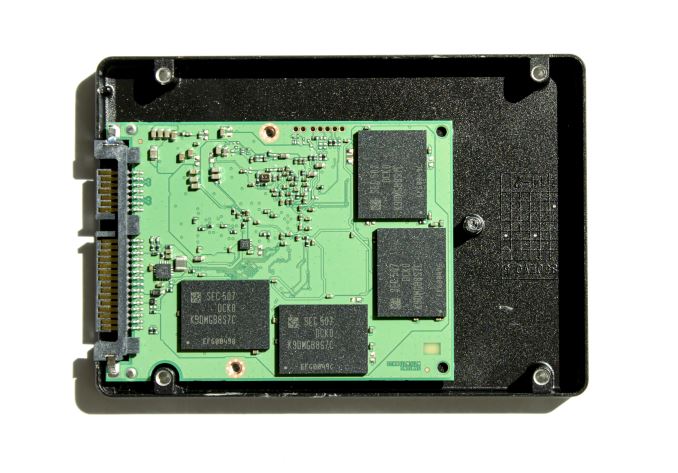The 2TB Samsung 850 Pro & EVO SSD Review
by Kristian Vättö on July 23, 2015 10:00 AM ESTFinal Words
The 850 Pro and EVO are undoubtedly the best SATA 6Gbps SSDs on the market. The Pro has been holding the performance crown for the past year and it's starting to look like no SATA drive can dethrone it, whereas the EVO provides very competitive performance at a much more affordable price point. From a performance standpoint, the 2TB models leave the Pro and EVO lines unchanged as the performance matches with the 1TB models already on the market. That's hardly a surprise given that the 1TB models saturate the SATA 6Gbps interface and AHCI presents its own limitations, so the 2TB SKUs are solely a capacity bump. There are minor performance differences in steady-state 4KB random write and random read benchmarks that favor the 1TB models, but to be honest that's merely an architectural observation (the internal SRAM caches in the controller may need upgrading to extract better performance out of +1TB of NAND) because the impact on actual user performance is in the order of a few percent.
I'm very glad to see improved power efficiency in the 2TB models. A part of that is explained by the move from LPDDR2 to LPDDR3, but it's also possible that the MHX is manufactured using a more power efficient process node. Depending on the benchmark the power savings can be anywhere from 5% to close to 20%, so it's not a marginal gain especially because higher capacity SSDs usually consume more power due to the additional NAND. The 850 EVO in particular wasn't very power efficient before, but the new 2TB is mostly on par with the 1TB-class drives we have tested. It's no challenger to the BX100 though, but TLC is inherently less power efficient and the SM2246EN controller is also less powerful by being a single-core design while the MHX consists of three processor cores.
At $800, the 2TB 850 EVO is very reasonably priced. The average going price for a 1TB-class value SSD is about $350-$380 with an occasional sale bringing the price closer to $300, so the 2TB EVO carries a small premium, but at $0.40 per gigabyte it's not overpriced by any means. The $1000 2TB Pro on the other hand has a much tinier niche because unless you have a The Destroyer level workload there won't be any difference in performance. Even under such an intensive IO workload the Pro only has a ~10% advantage, but the Pro is overall a little (~5-10%) more power efficient, so if you need a 2TB SSD and value every extra minute of battery life high, the $200 premium might be justifiable. The Pro also carries twice the endurance (300TB vs 150TB) and warranty (10 vs 5 years), but I don't consider those two having much value given that 150TB already translates to 82GB a day for five years and in five years time a SATA 6Gbps drive will most likely be obsolete anyway.
Since the 850 Pro and EVO are the first 2TB client SSDs on the market so they face no competition. They receive a strong recommendation from us for those who need/want a 2TB SSD. Both have excellent performance like the 1TB models we had already tested and the increased power efficiency is a welcome addition for mobile users. Out of the two the EVO is better value for the vast majority, but the 2TB Pro is there for those who want the added endurance and the most impressive SATA SSD in the market.












66 Comments
View All Comments
twizzlebizzle22 - Thursday, July 23, 2015 - link
Damn, we are in the future here. Roll in the day when my media storage drives are all SSD.Interesting as to why they managed to double the drive durability from 150TB to 300TB. That's pretty substantial.
joex4444 - Thursday, July 23, 2015 - link
Durability is the amount of data that can be written to the drive Samsung is guaranteeing can be written to it during its life. It's just related to the number of times a chip can be completely rewritten. If you double the capacity, you double the number of chips, and therefore you double the durability.lilmoe - Thursday, July 23, 2015 - link
Sure, but Samsung is also setting the older 512GB and 1TB at 300TB endurance rating up from 150TB previously, which is nice.SleepyFE - Friday, July 24, 2015 - link
If i'm not mistaken that was a marketing move. The EVO was sold as 150 so that people who needed more would buy PRO. There was a super punishing SSD test half a year back (a bit less maybe) where they tested how much the drives can take before the cells give up and even the EVO held out beyond 300. So they didn't really manage to improve anything, they just decided to extend their guarantee.leexgx - Saturday, July 25, 2015 - link
EVO not as reliable as the Pro (TLC EVO vs MLC PRO,) the pro drive never failed with bad data it silently failed at 2PBthe endurance is for warranty before where they have found errors have cropped up, the PRO drive use MLC so is reliably less error prone (as in they handle any minor errors better then TLC) then EVO under extreme loads (drives might look the same but the flash is not)
leexgx - Thursday, July 23, 2015 - link
sorry if this is been asked before, is the 25% OP been done via the ATA command that allows you to set amount of useable space or are you just partitioning it (both after a Secure erase)Samus - Thursday, July 23, 2015 - link
You don't even need to go that far. The Samsung Magician toolbox allows you to set a RAW OP "partition"leexgx - Thursday, July 23, 2015 - link
i looked online i guess it worked as i thought it would, you can use ATA LBA limit command to hard limit the OP space or just make the partition say 20GB less then the size of the SSD (or what ever size you want) this is assuming its a fresh drive or secured erased state, but the thing is TRIM does the same thing any way (assuming you don't fill the drive so it runs out of space) if you cant use TRIM then you need to set higher OP space (recommended any way)TEAMSWITCHER - Thursday, July 23, 2015 - link
Not quite yet.... I've been limping along with a pair of 840 EVO's waiting for this Samsung 3D flash in an m.2 form factor with a PCIe x4 with NVMe controller. All of this technology is mature, and my motherboard has the m.2 slot and BIOS support for NVMe, but Samsung hasn't put it all together yet. I'm not shelling out any more money for SATA III SSDs when I feel that any time now...Samsung will introduce the product I've been hoping for. Am I foolish to think this product in imminent?Impulses - Thursday, July 23, 2015 - link
Hmm, I'm not sure anyone could really say... It's plausible they might skip retail availability of the SM951 AHCI & NVMe versions altogether and release something with 3D NAND this year, but I think they haven't released the former to begin with because the demand just isn't there outside of OEMs.Might change after Skylake, might not, I doubt the average enthusiast is chomping at the bit to pay $1/GB for a drive but I dunno how much cheaper the SM951 would be in volume. I'm just aiming for a 256GB SM951 post-Skylake, for the OS, paired with 850 EVOs for storage.